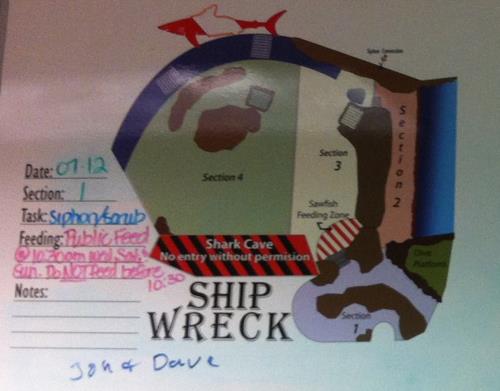 The Sharp, the Sleek, and the Nosy - Part 6 of Several Installments.
The Sharp, the Sleek, and the Nosy - Part 6 of Several Installments.Oddly enough, the Shark tank (“Shipwreck”) is one of the most tranquil exhibits at the Aquarium. From the Dive Platform there are two reef exhibits to left and right (Sections 1 and 2), while the open ‘arena’ where the sharks are stretches out in front (Sections 3 and 4). While the sharks and Great Barracudas can (and do) swim right over the dive platform and the reef areas, it’s considered bad form for a diver to be free swimming in the same part of the water column as the sharks, and you definitely don’t want to inadvertently trap one between yourself and a wall.
Dropping down to the right into the main part of the reef (Section 2), it’s a bit wider than the Dining Room Section 1 exhibit, but not by much. There’s a curved half-tunnel acrylic wall where guests gather to see the reef fish; here the puffer, angelfish, snappers, and others hang out, along with several small bamboo sharks.
For my initial orientation, Bill M and I swam along the bottom of the reef to an opening that leads to the shark arena. First checking (and listening) to be sure none of the big guys are aggravated, we scuttled along the wall to a trench that runs along the back of the arena. Several more bamboo sharks were resting there, and we had a front row seat as Grey Reef, Sand Tiger, and Zebra sharks cruised by and over us. There are also three Sawfish (Popeye, Bluto, and Olive Oyl) that run up to 15 feet long – 3 or 4 feet of which is rostrum equipped with inch long, wickedly sharp, fully exposed teeth. One look and it’s obvious why Pacific Islanders used them as weapons!
We continued along the trench, then skimmed the bottom to a ‘coral head’ in the middle of Section 4. Climbing to the top of this 5 or 6 foot structure we were at eye level with the sharks and watched them circle us. Then we dropped back down to the bottom to cross the rest of the arena back to the outer portion of the reef area, pausing a couple of times as a Sawfish crossed our paths.
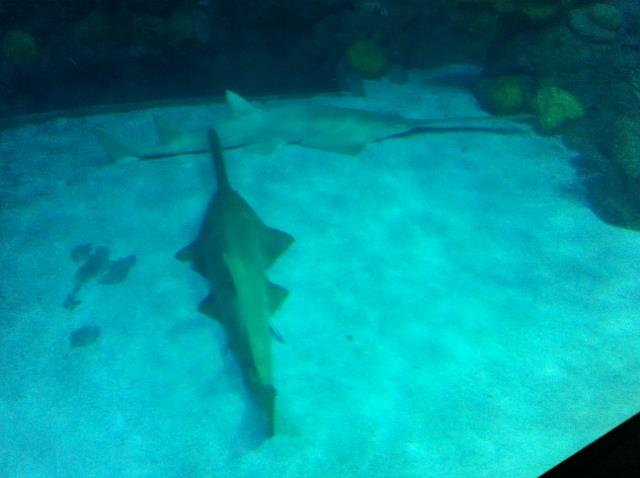
The sharks are fed by the Aquarists from the surface – divers only feed the reef and Sawfish. Bill demonstrated: lying down on the bottom between some rocks (the feeding station), a full squid is placed in a claw at the end of a 3 foot pole, then slid along the bottom. The Sawfish have learned that when a diver is at the station, they’re going to get fed, and today they seemed to almost line up and politely wait their turns. Much like a ray or shovelnose, the Sawfish mouth faces somewhere between down and forward, so they cover the food with their body, then with a jerk suck it in and move away to chew.
When Bill was done feeding, I took up the feeding position – sure enough, even though I didn’t have any food or feeding equipment, Olive Oyl approached, getting so close that when I put my palm up in front of my chest, she nudged it, then jerked and swam away.
There’s a large puffer fish in there which seems to have puppy genes – when we appeared with feeding containers, he came right up and hovered in front of us, almost as though he was begging. I was able to entertain the guests by holding a piece of shrimp in front and leading him around (briefly) until he was well positioned in front of the window, then releasing the food and he’d suck it in. I could see some of the younger kids were delighted by the show.
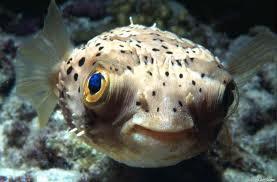
I had my first major equipment failure of my life: as I was swimming thru a narrow part of the reef, my regulator hose caught on an outcropping. I felt a momentary tug, then saw the hose and regulator drifting off to my right, while the mouthpiece remained gripped by my teeth! It actually took a moment for me to realize what had happened. Although regulator recovery is one of the first skills one learns when diving, and I’d deliberately taken out and replaced my regulator many times before, this was something different. The physical sensation of having the mouthpiece still in my mouth but knowing there wasn’t any air on the other side, created a weird conflict in my head. I switched over to my back up regulator, signaled Bill that I needed to surface, and spent the next 10 minutes swapping out regulators so I could continue the dive.
My second Shipwreck dive was fairly uneventful, though there were some high-points. Since it was a Thursday all we were going to do was siphon and scrub, but the Aquarist in charge of Shipwreck asked us to feed the reef fish.
Siphoning Section 2 is very easy, since it’s just a narrow straight section of sand. This is the area that the Bamboo sharks have been hanging out – only about a foot to a foot-and-a-half long, they seemed to be very curious about the siphon. They would swim up quite fast, then put on the brakes and settle with their noses barely an inch away from the opening, even allowing me to suck gravel right out from under them.
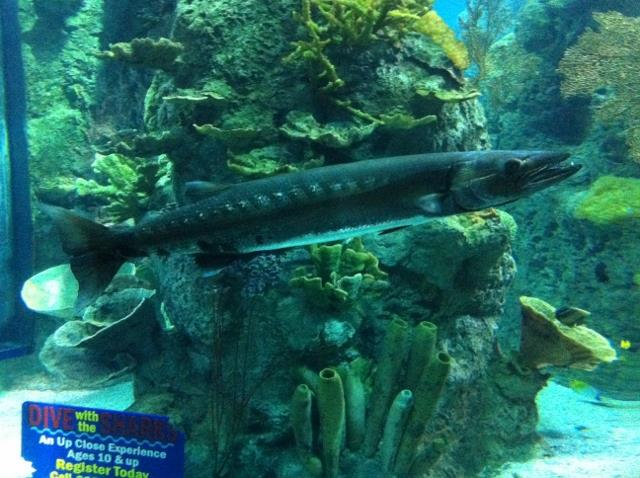
Section 1 is much more challenging to siphon – there’s several narrow nooks and crannies and crawl-thrus to navigate, and when there’s a large siphon to be maneuvered it became a bit of a game to remember to check to be sure I wasn’t about to rip off a piece of coral or sponge with the hose that was trailing behind.
At one point I felt a tug on the hose and turned around to see one of our sea turtles (Leonardo, I believe) had settled directly over it, and was beginning to crawl forward along the length of the hose. It had me cornered with a couple of bamboo sharks in a very narrow space; fortunately vertical movement is usually an option when you’re underwater, so the three of us finally lifted off the bottom; the sharks swam away and I hovered until Leo had tired of the game.
After feeding the fish in Section 2, my instructor Jon D and I went to the coral head in the center of the arena in Section 4 to feed the various beasties that live around it, including a huge Napoleon Wrasse. Feeding was pretty straight-forward, in full view of the guests, which included my co-worker Rich C and his family. At one point one of the Sand Tigers made a very slow pass between me and the back wall. I could see his eye swiveling around watching me, and I’m sure I made a bit of a spectacle of myself as I threw a few pieces into the water, then spun around to check the position of the shark. With their snaggle-teeth and half-open mouths, they’re far more intimidating than the Grey Tip Reefs and Zebra. Then, after I was done and was swimming back to the trench, Jon signaled for me to look up; I found myself barely a foot away from the belly of a Sand Tiger! I’d forgotten to get down against the bottom on my way across the arena, and nearly ran into one of the bosses of the exhibit.
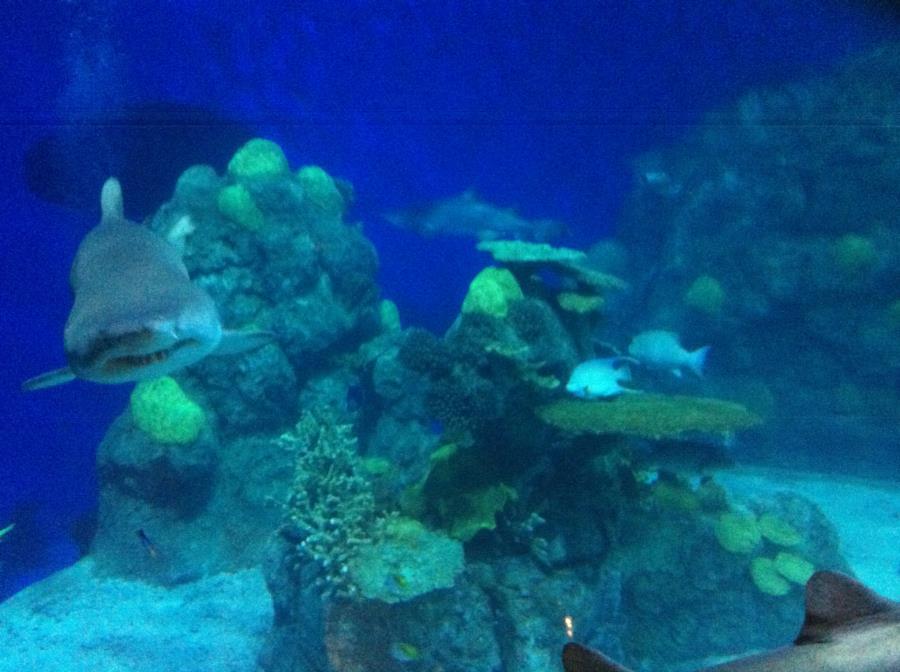
My third dive in Shipwreck (2nd dive as far as training was concerned, since on my previous dive we didn’t feed the Sawfish) included a second trainee as well as two trainers. We had 45 minutes to siphon and scrub Section 1 before starting the feeding, so Charlie and Ashley sank the siphon. As they were pulling it thru the water, I discovered that the hose had disconnected at the mid-way point, so I had to grab both sections and reconnect them, underwater, while also trying to make sure that as they pulled the hose thru they didn’t get hung up on anything.
During the scrubbing we were shown a couple of intakes in the arena to be cleaned, one of which was in the trench, which is normally thought of as the ‘safe zone’ that the sharks don’t usually enter. When we were done scrubbing it out, we turned to go back along the trench to the reef, only to find ourselves face-to-face with one of the Sand Tigers! They’re very slow moving, and it had glided into the trench and was gently approaching us. It was unclear what its intentions were, so we just moved to the sides of the trench and held still. It got to within a few feet, then veered off back into the arena.
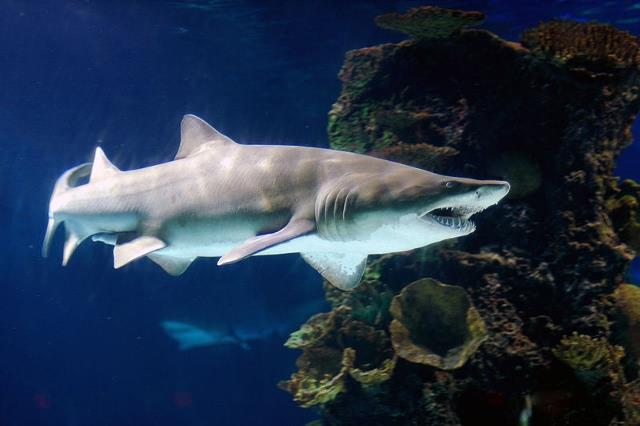
Feeding the Sawfish was a rodeo: despite our efforts to ward it off, the large puffer managed to snag one of the filets and take off with it. It was somewhat comical to see it trying to engulf a piece of fish that was so much larger than it was used to, especially since its mouth and jaws are designed for crushing, rather than slicing and grinding softer foods.
Then, Olive Oyl managed to snag the claw and take off with it, along with her squid. She dragged it around the arena for a minute, let go of it, then ended up settling right on top of it near the seamount. We all had to wait until she got tired of sitting on the claw and finally glided off, before we could retrieve it.
During my fourth dive in Shipwreck I was assigned to be the ‘Tender’ while I watched the feeding. As I siphoned section 3 I watched the three Sawfish circling the arena – their paths took them quite close to me each time they passed, and I was able to see differences such as tail shapes and missing teeth, which would help during the feeding to keep track of who’d eaten how much of what. At one point the Zebra shark got in the way of Popeye, just as he passed by me. There was a brief tussle as they jockeyed for swimming rights (Hey! I’m SWIMMING here!!), and then I suddenly got a (thankfully) brief close up of Popeye’s rostrum and teeth as he swung around and changed direction. A little while later I looked up and saw all four of the Sand Tigers passing each other directly above me at different levels in different directions. Given how slow they cruise, and since I’d been warned to try to avoid bubbling the sharks with my exhaust, I learned a new meaning to the expression, “Waiting to Exhale.”
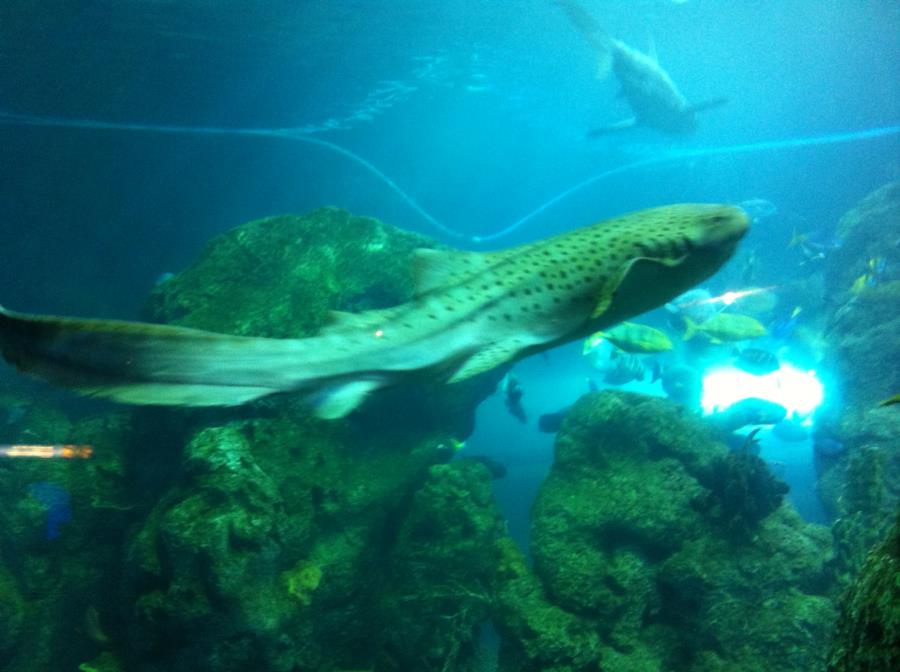
We expected the Sawfish to be very hungry, since they’d not been fed since Sunday; we had 8 squid and a mackerel filet for each of them, but to our surprise they each only ate about 4 squid, and literally turned up their noses at the mackerel.
While Bill crouched in the archway, he was swarmed by the bamboo sharks trying to get at the food. At one point he’d positioned a squid in the claw and extended it to Olive Oyl; as she was approaching it, one of the bamboo sharks darted in under her – the way they were both jerking back and forth we thought for sure Olive was going to have herself a shark snack, but a moment later the bamboo swam away with the entire squid gripped firmly in its teeth. It swam right by me, struggling to bite thru its ill-gotten gains, but avoided my feeble attempt to grab the squid, and kept the food all to itself.
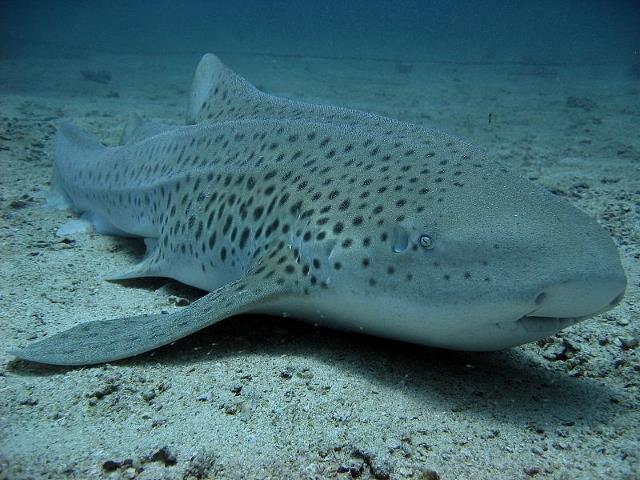
Tending wasn’t too difficult, as I was positioned above and to the side of the feeding arch; the bamboo sharks were out of my reach so I couldn’t do anything to help Bill, and the smaller fish avoided us altogether. The Zebra tried to horn in a couple of times, but I just kept the Tending Pole in front and it eventually got the hint and finally took off. The major lesson I had was that the Sawfish had a tendency to swing their rostrums up and to their right after they’d grabbed their food – this made their saws pass within a foot or so of me, and I quickly learned to back out of the way when it looked like they had their food.
Dave Madorsky lives with his wonderfully supportive family in the Denver Metropolitan Area; his personal philosophy is, “Anytime I’m underwater and still breathing is a GOOD time!”Disclaimer: Most pictures were taken by Dave Madorsky, but some are from public domain sources to better illustrate the sea life described.